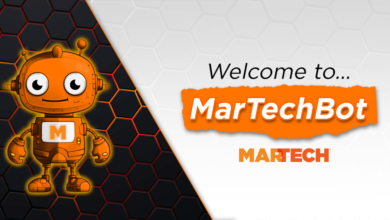Top 5 Lessons Learned from Databricks’ Journey from $400M to $1.5B+
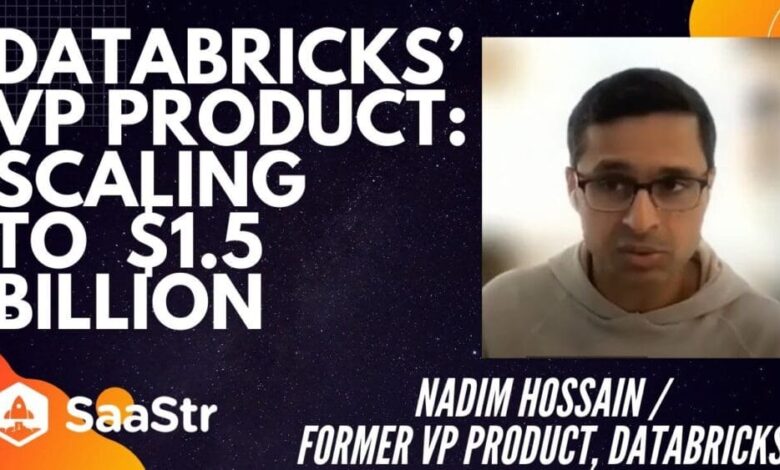
Databricks had an incredible scale-up from $400M to $1.5B+ during former VP of Product Nadim Hossain’s time there. The company has gone from 1600 employees to over 5500 and most recently crossed the $2B ARR mark. 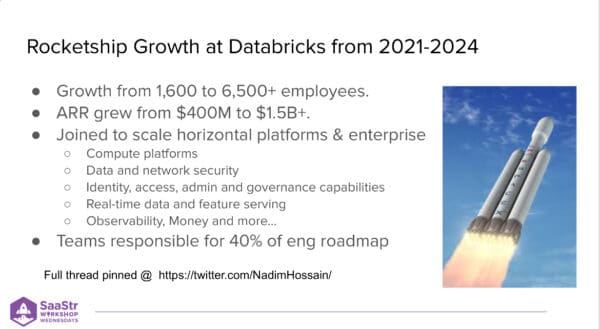
Now, he shares his top five learnings during his time at Databricks. His role covered about 40% of the engineering roadmap, which was all things Enterprise-focused.
Lesson 1: Innovating with First Principles
First principles is when you make an assumption about something and then break down that idea into its fundamental parts to find solutions. These are Databrick’s cultural values, so it’s unsurprising that it evolved from a single-product company to a multi-product company today. They’re fulfilling their vision of a unified data platform.
Like many SaaS startups, Databricks had a big vision from the beginning, when people believed that no one cared about a unified data platform. That was the reaction from the industry for a good chunk of the company’s evolution.
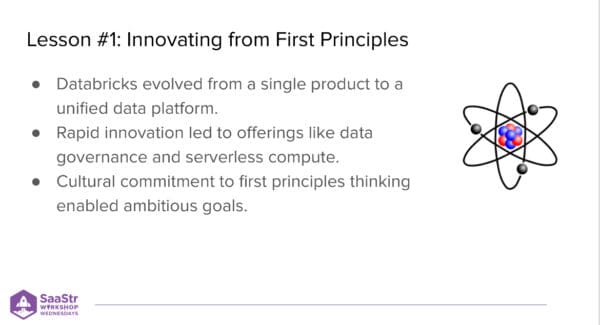

They achieved product market fit with data engineers who thought it was a better product from a price and performance standpoint. To the founders’ credit, they saw that path because they were thinking from a first principles lens.
They saw the way the industry would and should go.
In 2021, when Nadim joined, Databricks made two very big bets.
- Serverless compute
- Unified data governance
They were massive changes. From Nadim’s observations, they wouldn’t have made it there if it hadn’t been for the founders’ way of thinking about ideas and concepts from a first principles standpoint.
Serverless computing meant a snappy user experience, and a unified data platform meant some sort of governance so someone could access this table and not that one. They were ambitious goals that were successfully executed on.
Lesson 2: Founders and Leaders Diving Deep
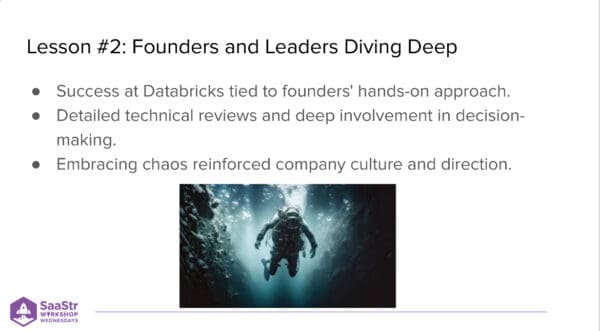

The “dive deep” cultural principle isn’t unique to Databricks. It’s very common with good founders and can drive a startup team crazy. It’s also a crucial part of many company successes, including Databricks.
The founders were very hands-on with R&D and other aspects of the organization, such as detailed technical reviews. There was a sense of co-ownership between the engineering team and tech leaders diving deep on these tech reviews.
One of the tradeoffs of this dive-deep approach is that it takes time, and it can be daunting for a product manager to do reviews with the CEO. You need to hire people who can handle that and think it’s exciting because the real benefits from this approach are high-quality decisions based on deep involvement.
Lesson 3: Finding “Navy Seal” Product Managers
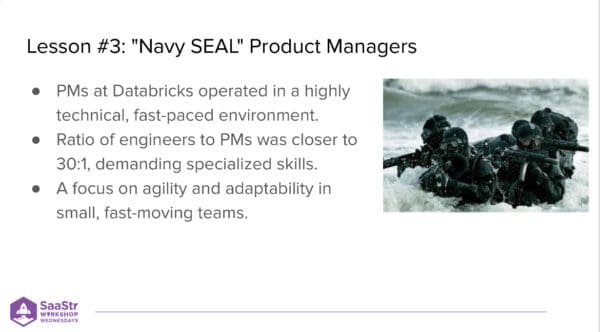

When Nadim joined Databricks, three people in his entire organization covered 40% of the roadmap, and there were already hundreds of engineers. He had to figure out who the company was, how it operated, and what kind of person could succeed there. It isn’t copying and pasting. It’s more like 3D printing customer Product Management models, which should be true for every startup.
The KPI he would use for a fast-paced environment and ambiguity was the rate of growth: the rate of growth of the company and the rate of change in the industry. Databricks was growing at 90% at $400M, which is wild. A lot of that was thanks to the industry. The timing and need were so great that customers were practically pulling the product out of their hands.
Internally, this can be challenging. You’re hiring new people and adding new customers, and a lot of chaos is happening. Product Managers had to operate at that pace, so you couldn’t hire and train people straight out of college.
In 2021, with only 15 product managers in total, they had to find folks with 10+ years of experience in product management who could thrive in this world — the Navy Seal of Product Managers.
You need people with a lot of training in their prior career, a lot of skills, and could context shift and do different things. They needed to be adaptable and agile and work across every part of the organization.
Lesson 4: Build What Customers Want


Databricks was very focused on the customer, which is slightly contrarian because this is a very technical domain. Yet, there was an immense focus on what customers wanted, and many founders miss this when they’re so focused on building cool stuff. They miss what customers want. You can’t miss this.
Driving product development based on customer feedback doesn’t mean you’re an order taker or don’t enter new segments. It means that when you have a vision, it’s more of a North Star that you iterate towards. The steps aren’t dogmatic, with a clear path.
Instead, you’re climbing a mountain and paying attention to the conditions and the different paths in front of you. Then, you make decisions based on those conditions and feedback on your way to the peak.
The iterative nature of the roadmap was essential to Nadim’s team and across other teams. The industry is changing quickly, and it’s hard to go wrong when you stay grounded in the customer’s needs.
Lesson 5: Move Fast and Embrace Messiness
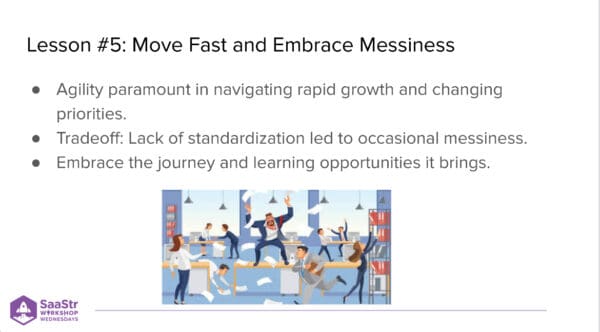

Moving fast is essential, and embracing the messiness encapsulates the tradeoffs that you won’t have perfect processes or the perfect feature stack rank. Focusing on speed, agility, and navigating a rapidly changing landscape and company served Databricks well.
These traits are an attribute of many successful SaaS Companies. One of the tradeoffs includes not having a standardized way of doing a lot of things, like prioritizing. Databricks wasn’t optimizing for the process. They were optimizing for the outcome. The process was good but not buttoned down.
What it meant for employees and teams within the company was that sometimes, you have to embrace the journey and the opportunities it brings, tradeoffs and all. Embrace the messiness and be patient with it, especially if it’s a rocketship SaaS company.
Key Takeaways
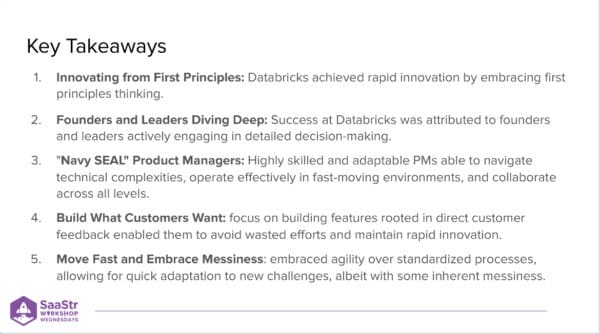

- Innovate from first principles. Databricks achieved rapid innovation by embracing first principles thinking.
- Founders and leaders should dive deep. Success at Databricks was attributed to founders and leaders actively engaging in detailed decision-making.
- Find “Navy Seal” Product Managers. Find highly skilled and adaptable PMs able to navigate technical complexities, operate effectively in fast-moving environments, and collaborate across all levels.
- Build what customers want. Focusing on building features rooted in direct customer feedback enabled Databricks to avoid wasted efforts and maintain rapid innovation.
- Move fast and embrace messiness. Databricks embraced agility over standardized processes, allowing for quick adaptation to new challenges, albeit with some inherent messiness.

